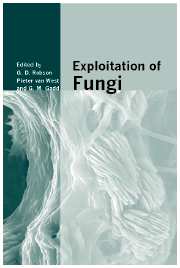Book contents
- Frontmatter
- Contents
- List of contributors
- Preface
- I Comparative and functional fungal genomics
- II Bioactive molecules
- III Protein folding and secretion
- IV Fungal bioremediation
- 10 Metal stress and the single yeast cell: Berkeley Award Lecture
- 11 Bioluminescence-based fungal biosensors
- 12 White-rot fungi and xenobiotics
- 13 Metal and mineral transformations: a mycoremediation perspective
- V Fungal biocontrol of pests
- Index
- References
12 - White-rot fungi and xenobiotics
from IV - Fungal bioremediation
Published online by Cambridge University Press: 05 October 2013
- Frontmatter
- Contents
- List of contributors
- Preface
- I Comparative and functional fungal genomics
- II Bioactive molecules
- III Protein folding and secretion
- IV Fungal bioremediation
- 10 Metal stress and the single yeast cell: Berkeley Award Lecture
- 11 Bioluminescence-based fungal biosensors
- 12 White-rot fungi and xenobiotics
- 13 Metal and mineral transformations: a mycoremediation perspective
- V Fungal biocontrol of pests
- Index
- References
Summary
Introduction
The word ‘xenobiotic’ comes from the Greek word ‘xenos’, which means ‘foreign’, and describes foreign compounds that are in direct contact with a living environment. Man-made xenobiotics have been dispersed directly into the environment for many years, dumped as waste products, applied as agrochemicals, or as a result of major accidents, or indirectly, in the form of emissions from incineration processes. Xenobiotic structures are not readily recognized by existing degradative biological systems and have accumulated in the environment, and although substantial progress has been made in reducing chronic industrial derived pollution there is a growing bank of contaminated derelict industrial land – so called ‘brownfield sites’ – in towns and cities all over the country. In order that these sites may be repurposed for housing or for building up new commercial areas, powerful and cost-effective decontamination strategies are needed.
The design of a decontamination strategy for a given site depends on the nature and concentration of contaminants, the site characteristics (especially water movement), and the extent of contamination. Directed bioremediation, an activity in which micro- and phyto-biological processes are used to degrade or transform contaminants into less toxic or non-toxic forms holds considerable potential as a strategy for in situ decontamination. It is generally cost-effective and less disruptive to soil and the natural landscape than ex situ techniques.
- Type
- Chapter
- Information
- Exploitation of Fungi , pp. 205 - 235Publisher: Cambridge University PressPrint publication year: 2007



